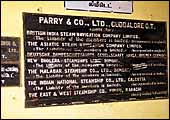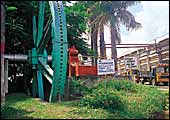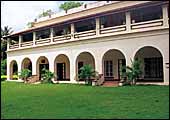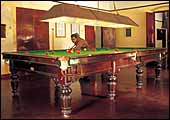|
It
may be the parry connection, but I know there must be a history
angle to a visit to EID Parry's sugar factory at Nellikuppam, 14
km from Cuddalore, a seaside town in Tamil Nadu, even before I leave
Chennai. Parry's Corner-where EID Parry's HQ, Dare House, is located-is
a Chennai landmark, the terminus for countless buses, the beginning
of what must once have ranked as one of the most scenic esplanades
in the world. This, wrote Chennai's best-known historian S. Muthiah,
was where French commander Comte de Lally based his artillery while
laying siege to Fort St. George in 1758-59. And this is where Dare
House, a building in the then prevalent art-deco style, came up
in 1940 (according to Muthiah, the top storeys were leased to the
American consulate, the Madras Chamber of Commerce and the European
Association, the forerunner to the European Union). Indeed, if history
were a currency, then EID Parry would perhaps be the most valuable
Indian company traded on that exchange.
The Murugappa Group acquired EID Parry in the
early 1980s, and being no stranger to history itself (that, though,
is another story, and one about which Muthiah has written extensively,
as indeed he has about those other Chennai institutions, Simpson
and Co. and Spencer & Co.-both, incidentally, are like Parry's
Corner, names assigned to bus stops in the city), has been punctilious
in its recognition and preservation of it.
| RELIC FROM THE PAST: EID Parry's sugar
mill at Nellikuppam dates back to 1845 and is one of the oldest
sugar factories in the world, if not the oldest operational
one |
My first brush with history at the Nellikuppam
sugar factory that dates back to 1845-it is one of the oldest sugar
factories in the world, if not the oldest operational one-is at
the entrance, where a burnished, well-preserved A7 W. Smith &
Cold (Glasgow) engine sits. The engine was installed in 1941, retired
in 1993, weighs 55 tonnes, and crushed some 210 lakh tonnes of sugarcane
in its lifetime. It isn't just history the engine looks upon, although
there is enough of that commodity: the old godowns, a tall brick
chimney that dates back to 1845, the adjacent A.J. Yorke Club, and
colonial bungalows. It also looks upon a petri dish of technological
and economic innovation. The farmers and the company are connected
through a revolutionary cordect network, a low-cost wireless technology
created by IIT, Madras' TeNet group headed by Ashok Jhunjhunwala.
And the company's balanced approach to optimise profits both for
itself and the farmers who supply it with sugar cane has come in
for praise from management guru C.K. Prahalad in his newest book
The Fortune at the Bottom of the Pyramid. These, though, are in
the realm of news, not history, which is what I have been assigned
to look for; for the record, this magazine wrote about the cordect
thing in 2001 (see "Selling To The Poor Profitably", Business
Today, June 21, 2001), in an article that was, coincidentally, based
on Prahalad's ideas on selling to the poor.
 |
 |
| The entrance to EID Parry's sugar
mill at Nellikuppam is adorned by an A7 W. Smith & Cold (Glasgow)
sugar-crushing engine (near left) that was installed in 1941,
crushed some 210 lakh tonnes of sugarcane, and retired in 1993 |
Of history, there's enough on display at Yorke
Club, from a huge rosewood billiards table, to a wooden bar (it
is a store for provisions now), to mouldering encyclopaedia and
other books dating back to the 1800s and 1900s to high-ceilinged
rooms with wooden rafters to furniture of the sort that can only
be seen in stores dealing in antiques. "Those days, the resident
British would send a peon to Pondicherry for fresh bread every day,"
says an employee.
Ironically, the man whose name the company
has taken, did not live to see the mill. Thomas Parry, a British
merchant adventurer, landed in India in 1788, when he was 20 years
old. By the time he died-in Cuddalore, of cholera, in 1824, and
his grave can be seen at the town's Christ Church-he had made three
fortunes, lost two, and established himself as one of India's leading
businessmen. Even his nephew David Pugh (the original distillery
licence is in his name) was probably not responsible for much of
what can be seen at the Nellikuppam factory today.
The sugar business and much of Parry & Company's
other interests in the region were run from the company's offices
in Old Cuddalore, where they were located in the East India Company's
Factory House that dates back to the 17th century. Today, the building,
which is still standing, houses the company's ledgers dating back
to 1853.
 |
 |
| There's a lot of history on display
at Yorke Club (extreme left). This includes a huge rosewood
billiards table (left), besides encyclopaedia and other 19th-
and 20th-century books, and furniture of the sort stocked only
in antique stores |
In 1897, East India Distilleries and Sugar Factories
Limited was incorporated in London; this acquired most of the assets
of Parry & Company in the South Arcot district of Tamil Nadu
where Cuddalore is located; in 1948, the company moved its seat
of management to Madras (now Chennai); in 1955, it became Indian-owned;
and in 1956, its name was changed to the current one, EID Parry.
The Nellikuppam sugar factory ran into a trough of problems-labour
unrest, deteriorating relationships with farmers, inability to make
a go of the highly-regulated sugar business-before it was acquired
by the Murugappa Group in 1981. The group embarked on a drive to
increase efficiency and reduce workforce but realised, wisely, that
the key to its success lay in winning over the farmers, many of
whom still possess indigo-cultivation agreements their forefathers
struck with Thomas Parry; M.M. Venkitachalam, a member of the Murugappa
family and a qualified agriculturist, was deputed to win back the
confidence of the farmers. "Today, we have some 25,000 farmers
in Nellikuppam and this mill continues to crush the highest amount
of cane in the state of Tamil Nadu, for the fourth year in a row,"
gushes P. RamaBabu, MD, EID Parry. This year, the mill will crush
some 12-15 lakh tonnes of cane, and provide employment to some 7,000
people (the sugar division returned operating profits of more than
Rs 34 crore on sales of Rs 415 crore in 2003-04). And to think it
all began when Thomas Parry acquired two ailing indigo ventures
in Cuddalore belonging to two British merchants, Colonel Cullen
and Edward Campell, between 1807 and 1809.
|
